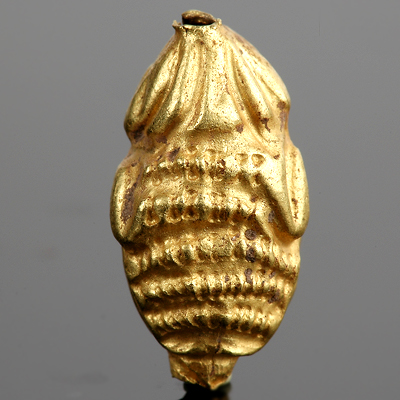| Re: tircul gold + name the bug! | |||||
| Re: pyu gold -- tofsla | Post Reply | Edit | Forum | Where am I? | |
01/30/2013, 10:56:22
1. If you think all ancient gold is the same colour (even ancient gold from the same place and time period) you should really check out some good museum collections. In fact, there is a huge variety of shades, ranging from bright yellow to almost-orange, and patinas; the variations are produced of course by different burial conditions. A yellow colour has nothing necessarily to do with cleaning in acid, nor is a deeper colour a guarantee of authenticity.
2. Dirt. Well, everyone who collects antiques know that this is the first thing that fake-makers use to try to create an impression of age. I have a friend in Si Satchanalai in Thailand who makes fake Sawankhalok ceramics, and he routinely smears a mixture of earth and guck into the surfaces of his very pretty plates. Seems like a pity to me.
3. As I said before, it would be good to have some close-ups of your collection. It's not really possible to assess it from one picture. I like the look of it and would love to see it in more detail.
4. New methods have been developed for testing the age of gold - mainly for high-end coin collections. They're expensive and not always completely reliable, but if one is buying items in bulk from a single source it could easily be worthwhile.
5. Provenance. Most of the time this is the best assurance we can get. If you trust the dealer you bought the beads from, good for you. But do be careful; there are many horror stories (see 9). The elephant/chank-shell/ox bead was collected more than thirty-five years ago from the Halin area, well before the present fashion, and I have documentary evidence to prove it. That's what I call provenance. Similarly, because Jan (mosquitobay) is such an experienced collector and dealer with one of the best collections of ancient beads in the world, he must have built up a network of trusted and trustworthy suppliers. That's good provenance for the bead he showed.
6. Age. It's very interesting what you say about some of the beads being Tircul and some later from the Bagan period. Which ones? It would be really useful to have more information about this.
7. Have you tested the gold content of the beads? It occurs to me that if they are like the gold coins from Sriksetra and other Southeast asian sites the gold content is likely to vary according to date, earlier being higher. Again, it would be really interesting to know more about this.
8. Hendrik's image. Sorry, Hendrik, but it looks very good to me too!
9. Horror stories. Buying in bulk from a single dealer is very tempting; it's an instant collection. But it can be quite risky. For quite a long time, I've been a consultant on Southeast Asian artefacts to a number of different museums and institutional collections, and I sometimes get asked to assess private collections too. Here are a couple of the saddest stories I've come across:
- a few years back, I was asked to look at a collection of Vietnamese ceramics assembled by a Vietnamese-American collector. They supposedly came from a shipwreck in Indonesian waters. Several hundred pieces; pictures of individual items prior to cleaning; over $100, 000; an instant heritage. But more than 90% were fake. About half had been bought in Singapore. Then the buyer decided to by-pass the Singapore dealer and went to the source in Indonesia. He thought he was being clever, saved 50%, and ended up throwing even more money down the drain. At first, when I pointed out to him the signs that ought to have been obvious, he wanted to kill me; then he wanted to kill the dealer! Now and again some of the fakes appear on eBay, so somebody is going to get cheated all over again.
- just last year, I was asked to examine a European collection of early Vietnamese bronzes from the Dong Son period (1st millennium BCE). At first the collector had acquired pieces gradually, and most of these were authentic, but then he had connected with a dealer in Bangkok who had sources in Vietnam. He checked out the story and I guess it seemed credible, so he bought close to a hundred objects for a large amount of money, and they really were beautiful. But as I looked at them the doubts grew in my mind for stylistic reasons and so we had several of them tested by a laboratory in Brussels. The composition of the bronze was all wrong; they were all recent fakes. I happen to know the dealer in Bangkok (River City and the Oriental, not Chatuchak), and I don't believe he is a crook. He made a mistake, a big mistake, and the collector paid for it.
Over the years, there have been contributors to this forum who have done the same kind of thing. To my mind, it's better to vary one's sources so that one can keep on comparing. Everyone who collects buys fakes at one time or another; one has to find the best way to learn in the process.
Sorry to go on so long. For anyone who gets to the end, the pics are of another Tircul gold bead, also from near Halin and collected more than 35 years ago. It seems to be in the shape of some kind of bug; on top it looks like a cicada but not on the underside.
Cheers,
Will


|